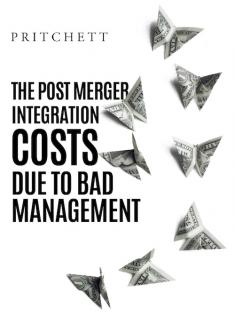How can you tell if a merger is being mismanaged? You will see several of these major problems and the post-merger integration costs that accompany them:
LOST TALENT
Bailing out by managers and executives is one of the first signals that a merger is being mismanaged.
Typically, some of the best talent is the first to go. And their leaving more than likely means that somebody in the top ranks of the company made a mistake. There was something someone did, or didn’t do, that helped produce the bailouts.
Parent company executives have to move fast and do the right things to keep the people who count. Too often, though, just the opposite happens. The acquiring firm drags its feet and does things clumsily.
Many factors contribute to the turnover statistics in mergers. People leave for myriad reasons—some that make sense, some that don’t. But the point is that many of these people are very valuable employees, and they could have been retained.
So what does the loss of talent cost a company? First, there are some tangible, easily identifiable expenses associated with replacing a key manager or executive such as placement/search fees, relocation costs, training costs, and the time invested in the selection process.
The intangible costs associated with losing a key person are harder to gauge, although they can easily represent an even more expensive proposition.
Usually a company not only loses some of its own talent but also ends up strengthening the competition.
The most obvious place for a talented individual to go is to a competing firm where his or her skills are immediately transferable and actively sought.
There also are times when acquirers end up paying for people who aren’t there. Mismanagement can frustrate and aggravate key players to the point that they decide to bail out and pull the cord on their golden parachutes. This is like the opposite of a signing bonus —top talent people basically pocket a big chunk of money and quit.
PRODUCTIVITY DECLINE
Only a handful of senior people are likely to have such a ripcord to pull. Most people feel they have no good alternatives, so they stay and endure their frustrations. But the company can very easily end up paying for people who come to work but don’t work.
When mergers are mismanaged, productivity never escapes unscathed. If a firm can quantify it, there will be disturbing financial evidence of how mismanagement carries a cost in terms of weaker productivity. The work hours that are lost without any meaningful output add up in a hurry
When the merger is marked by weak leadership, poor communication, a lack of decision making, and so on, productivity takes a beating. As job commitment and employee morale weaken, less effort is put into the task at hand.
These people very often will feel, and accurately so, that they are working harder than ever. But so much time, effort, and mental energy are being invested in merger-specific activity that the more basic business itself actually receives less true attention. To make matters worse, poor quality work creates another set of future problems that carry a hefty cost.
The merger impact studies conducted by PRITCHETT indicate a minimum 15% loss in performance effectiveness among middle managers who are involved in the merger integration process. Senior executives have a much higher statistic.
WEAKENED COMPETITIVE POSITION
A merger produces many distractions that cause employees to focus on themselves and the inner workings of the organization rather than on the marketplace. To put it differently, people take their eyes off the ball. Personal concern for their own careers is heightened, while concern for the company slips.
Companies that are being acquired and merged almost always have a difficult time maintaining their competitive edge. The more the integration process is mismanaged, the more the company is likely to lose existing market share or miss opportunities that come along to gain ground.
Soldiers who are poorly led show little determination. They are not aggressive. And when the corporate troops become preoccupied with themselves and demoralized about their work, they lose their fighting spirit. Sales drop off. Customer loyalty deteriorates. Competitors smell blood and rush in for the kill.
Competitive position can be ravaged when the integration phase is prolonged or poorly managed.
DISILLUSIONED WORKFORCE
During a merger, employees often feel unrepresented and vulnerable They worry about losing seniority and some of their benefits. It strikes them as unfair that they have to adapt to the acquirer’s policies and procedures. They grow frustrated with their inability to get answers, and feel they have no one they can safely turn to with their problems and complaints.
People, frequently at many different levels in the firm, talk about being “sold out” by the owners or the most senior executives. Frequently, they look at the management contracts, golden parachutes, and special severance arrangements the top brass arrange for themselves and talk resentfully with each other about how the people in charge line their own pockets.
Employees witness major layoffs and feel they have little hope of success at defending their best career interests as individuals. Psychologically, they seek safety and security. But their bosses, the people in the management ranks, generally are themselves stressed out to a large degree. Their work is demanding more of them, and they have their own personal interests to worry about. So managers may do a poor job of offering nurturance and support. Typically, they don’t even do as good a job of communicating as they would under normal business conditions.
When the usual merger dynamics are set in motion, there’s a surge of ambiguity and uncertainty, a drop in the trust level, and self-protective behaviors on the part of employees. That in turn, produces the customary organizational problems: communication difficulties, loss of team play, power struggles, low morale, and weak commitment.
MISCAST MANAGERS
One of the most common results of mismanaged mergers is bad staffing decisions. And those decisions, in turn, contribute to further mismanagement as the integration process continues.
The way many companies, even big and supposedly sophisticated firms, approach the staffing issue is often indefensible. The decisions regarding who will go, who will stay, and who will go where are made on the basis of expediency, favoritism, hunches, first impressions, highly questionable secondhand information, and negotiated trade-offs. The result, obviously, is that important management and executive slots are filled by misfits.
A man who is strong technically but doesn’t have a nickel’s worth of management aptitude or interpersonal skills is tapped to head up a research and development function. A highly structured, deliberate, slow-paced person is named to a vice president’s job that involves vague assignments, requires a high tolerance for ambiguity, demands decisiveness, and desperately needs someone with a sense of urgency.
These people are going to fail. Th ey are going to cost the company a lot of money and cause misery for others.
Why did they get these jobs in the first place? The R&D fellow just happened to be in the wrong place (for the company, that is) at the right time. His boss, who would have been the obvious choice, and who could have done a good job, had joined a competing firm a few weeks before the merger.
He had not been replaced. So the company made one of the common staffing mistakes: struggling to work with what you have instead of going aft er what you need.
The vice president ended up in his slot because the two merging companies were swapping jobs and people in a lame attempt to be fair and equitable—sort of like choosing up sides—and this fellow had to go somewhere.
The best way, by far, is to involve experts in staffing decisions and restructuring issues. Th ey can bring objectivity plus a valuable background of experience that lets them speak authoritatively about things.
A good merger consultant will challenge faulty reasoning, and also can speak with frankness about someone’s qualifications when management might feel uncomfortable being so blunt. Let the consultant be the “heavy” and help broker the negotiations on sensitive staffing issues.
Miscasting of people can cost a great deal. It sometimes results in overstaffing, and that obviously means unnecessary names on the payroll. It may also result in understaffing, which can be just as costly or even more expensive.
The people who are going to carry major responsibility for managing the merger process need to possess several key characteristics:
- High-energy level
- Flexibility and the ability to improvise
- Decisiveness
- Strong interpersonal skills
- A willingness, and ability, to take charge
- A knack for keeping many balls in the air simultaneously
- A keen sense of urgency
- High tolerance for stress and pressure; psychological resilience
These are characteristics that equip a person to manage transition and be an agent of change.
If the right people are in charge, many problems will be prevented, and they will be able to cut the firm’s losses on those that cannot be avoided.





